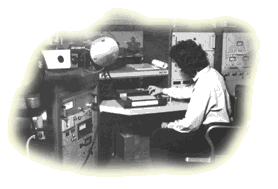
Radiation Measurement
The discovery of the natural radioactive decay of uranium in 1896 by Henry Becquerel, the French physicist, opened new vistas in science. In 1905, the British physicist Lord Rutherford--after defining the structure of the atom -- made the first clear suggestion for using radioactivity as a tool for measuring geologic time directly; shortly thereafter, in 1907, Professor B. B. Boltwood, a radiochemist at Yale University, published a list of geologic ages based on radioactivity. Although Boltwood's ages have since been revised, they did show correctly that the duration of geologic time would be measured in terms of hundreds-to-thousands of millions of years.
The next 40 years was a period of expanding research on the nature and behavior of atoms, leading to the development of nuclear fission and fusion as energy sources. A byproduct of this atomic research has been the development and continuing refinement of the various methods and techniques used to measure the age of Earth materials. Precise dating has been accomplished since 1950.
A chemical element consists of atoms with a specific number of protons in their nuclei but different atomic weights owing to variations in the number of neutrons. Atoms of the same element with differing atomic weights are called isotopes. Radioactive decay is a spontaneous process in which an isotope (the parent) loses particles from its nucleus to form an isotope of a new element (the daughter). The rate of decay is conveniently expressed in terms of an isotope's half-life, or the time it takes for
one-half of a particular radioactive isotope in a sample to decay. Most radioactive isotopes have rapid rates of decay (that is, short half-lives) and lose their radioactivity within a few days or years. Some isotopes, however, decay slowly, and several of these are used as geologic clocks.
Dating rocks by these radioactive timekeepers is simple in theory, but the laboratory procedures are complex. The numbers of parent and daughter isotopes in each specimen are determined by various kinds of analytical methods. The principal difficulty lies in measuring precisely very small amounts of isotopes.
The potassium-argon method can be used on rocks as young as a few thousand years as well as on the oldest rocks known. Potassium is found in most rock-forming minerals, the half-life of its radioactive isotope potassium-40 is such that measurable quantities of argon (daughter) have accumulated in potassium-bearing minerals of nearly all ages, and the amounts of potassium
and argon isotopes can be measured accurately, even in very small quantities. Where feasible, two or more methods of analysis are used on the same specimen of rock to confirm the results.
Another important atomic clock used for dating purposes is based on the radioactive decay of the isotope carbon-14, which has a half-life of 5,730 years. Carbon-14 is produced continuously in the Earth's upper atmosphere as a result of the bombardment of nitrogen by neutrons from cosmic rays. This newly formed radiocarbon becomes uniformly mixed with the nonradioactive carbon in the carbon dioxide of the air, and it eventually finds its way into all living plants and animals. In effect,
all carbon in living organisms contains a constant proportion of radiocarbon to nonradioactive carbon. After the death of the organism, the amount of radiocarbon gradually decreases as it reverts to nitrogen-14 by radioactive decay. By measuring the amount of radioactivity remaining in organic materials, the amount of carbon-14 in the materials can be calculated and the time of death can be determined. For example, if carbon from a sample of wood is found to contain only half as much carbon-14 as that from a living plant, the estimated age of the old wood would be 5,730 years.
The radiocarbon clock has become an extremely useful and efficient tool in dating the important episodes in the recent prehistory and history of man, but because of the relatively short half-life of carbon-14, the clock can be used for dating events that have taken place only within the past 50,000 years.
The following is a group of rocks and materials that have dated by various atomic clock methods:
|